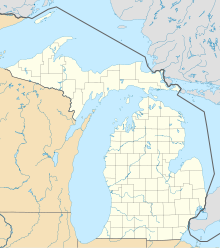Kincheloe AFB
| Kincheloe Air Force Base | |
|---|---|
| Part of Strategic Air Command (SAC) | |
| Kinross Charter Township, Michigan | |

2006 USGS photo
|
|
|
location of Kincheloe AFB,
south of Sault Ste. Marie |
|
| Coordinates | 46°15′03″N 084°28′21″W / 46.25083°N 84.47250°WCoordinates: 46°15′03″N 084°28′21″W / 46.25083°N 84.47250°W |
| Type | Air Force Base |
| Site information | |
| Controlled by |
|
| Site history | |
| Built | 1943 |
| Built by |
|
| In use | 1941–1944; 1952–1977 |
| Garrison information | |
| Garrison | 449th Bombardment Wing |
Kincheloe Air Force Base was a U.S. Air Force base during the Cold War. Built in the Upper Peninsula of Michigan in 1943 during World War II, the base was in service until 1977. The base was known by various names, including Kinross Municipal Airport, Kinross Army Air Field, Kinross Air Field, Kinross Air Force Auxiliary Field, and Kinross Air Force Base. The present-day Chippewa County International Airport, Kinross Correctional Facility, and the community of Kincheloe are located on the site of the base. The base was named for Iven Kincheloe (1928–1958), a test pilot from Michigan.
During World War II, the Soo Locks were considered vital to the war efforts. An airport was planned in Kinross as early as June 1941. The airport was built by the United States Government through lease, license, easements and by fee of different tracts of land. A small airfield with three 5,520-foot x 300-foot runways was constructed in a triangle pattern with a small aircraft parking area and a few support buildings. The airfield was designated the Kinross Auxiliary Airfield, and was designated a Sub-Base of the Air Transport Command Alpena Army Airfield.
The mission of Kinross AAF was to serve as a refueling stop for aircraft headed for Alaska as well as to defend the locks of Sault Ste. Marie. However, no tactical units were assigned there during the war and the few support personnel who were stationed there were under the command of the 4250th Army Air Force Base Unit at Alpena AAF. The base was inactive beginning in 1945, and after the end of World War II, the airfield was leased to the City of Sault Ste. Marie for a civilian airport.
...
Wikipedia


